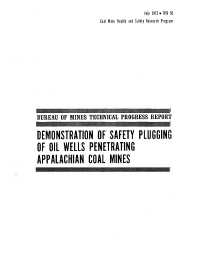Mining Publication: Demonstration of Safety Plugging of Oil Wells Penetrating Appalachian Coal Mines
Original creation date: July 1972
An oil well penetrating the Pittsburgh bituminous coalbed in northern West Virginia was plugged and safely mined through 3 months later. A sensitive chemical tracer, introduced into the oil reservoir before the test, was not detected in the mine air following the plugging and during mining of the pillar and penetration of the well. Effectiveness of the plugging in preventing reservoir gas from entering the mine through the well hole was verified by continuous monitoring of the mine air for indications of sulfur hexafluoride, an inert gas detectable in amounts as minute as 0.5 Part per billion. Expandable cement and fly ash-gel-water slurry were utilized to seal the well above and below the coal seam. Three other wells were also plugged using various techniques.
Authors: GE Rennick, J Pasini, FE Armstrong, JR Abrams
Reference - July 1972
NIOSHTIC2 Number: 10009769
U.S. Department of the Interior, Bureau of Mines. Technical Progress Report 56, NTIS No. PB-211350, 1986; :1-12
See Also
- Assessment of Technology for Non-destructive Testing of In-situ Underground Mine Seals
- Compendium of Structural Testing Data for 20-psi Coal Mine Seals
- Composition Change Model for Sealed Atmosphere in Coal Mines
- Development of a Method for the Remote Characterization of Underground Mine Ventilation Control by Multiple Tracer Gases
- Evaluating Ventilation Parameters of Three Coal Mine Gobs
- Explosion Pressure Design Criteria for New Seals in U.S. Coal Mines
- Explosion Pressure Design Criteria for Seals in U.S. Coal Mine - An Update on Work at NIOSH
- Progress Toward Improved Engineering of Seals and Sealed Areas of Coal Mines
- Seal Design
- Structural Analysis and Design of Seals for Coal Mine Safety
- Page last reviewed: 9/21/2012
- Page last updated: 9/21/2012
- Content source: National Institute for Occupational Safety and Health, Mining Program


 ShareCompartir
ShareCompartir
